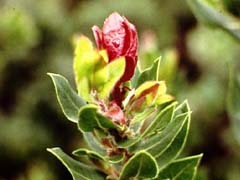Ericaceae consists of shrubs, tress, and perennial herbs, many of them familar as garden plants: rhododendrons, azaleas, heaths, heathers, and blueberries. The regular flowers usually have a 5-lobed calyx and a corolla of either 5 lobes or 5 separate petals, with 5 or 10 stamens. The fruit is fleshy or dry, and usually partitioned into 5 seed producing divisions.
Probably all members of Ericaceae have fungi associated with their roots, for proper breakdown and intake of nutrients. This makes them excellent places to scout for mushrooms - the delectable Hedge Hog Mushroom is usually found growing under Huckleberry thickets in late Winter.
Ericaceae are excellent for native gardens, particularly Western Azalea (Rhododendron occidentale), Huckleberry (Vaccinium ovatum) and Salal (Gaultheria shallon).
